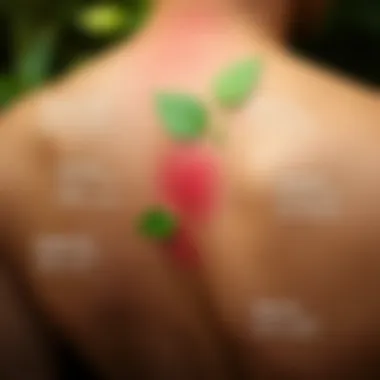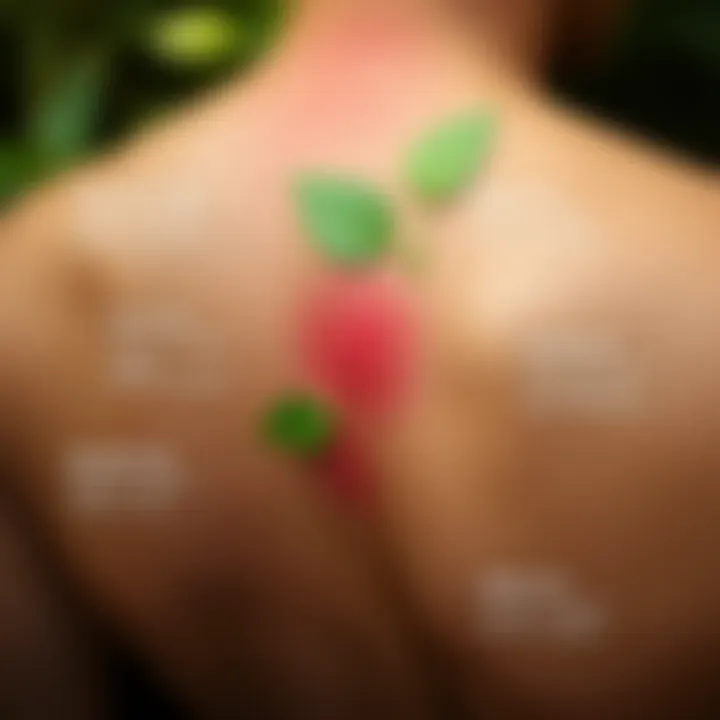Comprehensive Strategies for Managing Poison Ivy Rash


Intro
Poison ivy rash is an allergic reaction that can leave a person scratching their head—and other itchy spots. It's triggered by contact with urushiol oil found in the leaves, stems, and roots of the poison ivy plant. This rash is often more than a mere nuisance; it can impact daily living and even mental well-being in significant ways. In today’s article, we aim to tackle the various remedies and preventive strategies that will arm you against this common yet bothersome ailment. By reading through, you'll gain valuable insights into how to deal with symptoms, find relief, and ensure that you steer clear of poison ivy encounters in the future.
Let's delve deeper into the health benefits, practical tips, and essential strategies that can be employed to effectively manage poison ivy rash and promote a smoother path to recovery.
Understanding Poison Ivy
Understanding poison ivy is crucial for anyone who spends time outdoors. Poison ivy can lead to an uncomfortable rash, impacting daily life and activities. By grasping the fundamentals of this plant, individuals can better prepare and protect themselves against possible encounters.
What is Poison Ivy?
Poison ivy, scientifically known as Toxicodendron radicans, is a deciduous climbing vine or shrub native to North America. It has leaves grouped in threes, a detail famously summarized in the phrase "leaves of three, let them be." This plant thrives in a variety of environments, from wooded areas to backyards. Knowing what poison ivy looks like is the first step to avoiding its ill effects. Its growth can vary, appearing as ground cover in some regions and as a tall shrub in others.
Characteristics of Poison Ivy Plants
The characteristics of poison ivy are marked by several telling features. The leaves are shiny and can be smooth or jagged, usually bright green in the spring and turning red or yellow in the fall. Notably, the plant can produce small, greenish-yellow berries. These berries are often a food source for birds, which can inadvertently assist in its spread. Moreover, poison ivy’s roots and stems can grow hairy, giving it an almost vine-like appearance. Its ability to grow in various conditions only heightens the risk of coming into contact with it. As a precaution, it's wise to familiarize oneself with visuals or even current online images to distinguish it from harmless plants.
The Role of Urushiol Oil
Urushiol oil is where the trouble lies. This colorless, oily substance is found in all parts of the poison ivy plant. Even the smoke from burning poison ivy carries urushiol and can cause allergic reactions. When humans come into contact with this oil, it can trigger an immune response, leading to a rash that can appear and worsen over several days. The symptoms typically manifest as red, itchy bumps which may blister and ooze. Understanding urushiol and its effects is fundamental in both preventing exposure and treating resulting rashes.
"Prevention is the best medicine, especially when it comes to poison ivy. Knowledge is your shield."
By grasping these elements about poison ivy, individuals can take proactive steps to avoid exposure, minimize the risk of a rash, and address encounters effectively. Familiarity with the plant's characteristics and the role of urushiol is vital in fostering a safer environment for outdoor activities.
Recognizing Poison Ivy Rash
Understanding how to recognize poison ivy rash is not just a beneficial skill for outdoor enthusiasts, but also a crucial step in effectively managing this unwelcome ailment. A rash resulting from contact with poison ivy can lead to significant discomfort and disruption in daily life. Discerning the symptoms early on can help individuals take prompt action, alleviating their suffering and preventing more severe reactions.
Symptoms of Poison Ivy Rash
The initial reaction to poison ivy exposure may not be immediate. It can take anywhere from 12 to 72 hours for symptoms to manifest after contact with urushiol oil. This delay often catches people off guard, as they might believe they’ve escaped unscathed. The classic features of poison ivy rash include:
- Redness and inflammation of the affected skin area.
- Itchiness, which can be rather intense and lead to relentless scratching.
- Bumps or blisters that may ooze, providing a temporary sense of relief when they burst, but risk introducing infections.
- Swelling of the skin, further compounding discomfort.
It's quite easy to mistake a poison ivy rash for other skin conditions, such as eczema or dermatitis. However, the hallmark clue is the streaky or linear pattern of the rash, typically aligning with where the plant made contact with the skin. Being vigilant and attentive to these symptoms is key, as untreated rashes can lead to secondary infections.
Severity Levels of Reactions
The severity of a poison ivy reaction can vary from person to person, largely dependent on individual sensitivity to urushiol. While some may experience only mild irritation, others could suffer severe reactions that might require medical intervention. Recognizing the level of severity early can influence how one responds to the rash and when to seek help.
- Mild Reactions: These often involve localized redness and itchiness without swelling or large blisters. Over-the-counter treatments can usually manage these cases effectively.
- Moderate Reactions: Characterized by more pronounced itching, swelling, and the presence of numerous blisters. Individuals may need topical treatments or corticosteroids to mitigate their discomfort.
- Severe Reactions: In some instances, individuals can suffer from systemic reactions, which manifest as rashes that cover larger areas, severe swelling, or even respiratory distress. These cases warrant immediate medical attention as they can escalate quickly.
Queuing in to these symptoms and severity levels is not merely a precaution; it’s a proactive approach that fosters a better quality of life, especially for those who find themselves frequently in nature. Thus, recognizing and responding appropriately to poison ivy rash is essential for effective management and prevention of future concerns.
Immediate Remedies for Poison Ivy Rash
Dealing with poison ivy rash can feel like a wound that won't stop stinging. The importance of immediate remedies cannot be overstated. Having a solid action plan in place when one encounters this pesky plant is crucial not only for alleviating symptoms but also for preventing further irritation. Whether you’re out hiking or tending to your garden, knowing what steps to take when the unexpected occurs can make all the difference. Immediate remedies provide both physical relief and peace of mind, forming the first line of defense against a bothersome rash.
Over-the-Counter Treatments
When it comes to tackling the initial blow of a poison ivy rash, over-the-counter treatments often serve as a go-to solution. Medications containing hydrocortisone cream can diminish inflammation and itching, giving a timely respite from discomfort. For more severe reactions, products with diphenhydramine, like Benadryl, can be quite helpful.
Here are some options to consider:
- Hydrocortisone Cream: Used to reduce swelling and itchiness. A thin layer applied three to four times daily can make a noticeable difference.
- Calamine Lotion: This classic treatment serves to soothe the skin and reduces the urge to scratch.
- Antihistamines: Medications like Benadryl can block histamine release and ease allergic reactions, albeit with possible drowsiness as a side effect.
Make sure to read the instructions carefully, as different products have varying concentrations and usage recommendations. It is always wise to consult with a healthcare provider if there’s confusion or if this is a recurrent issue.


Home Remedies to Alleviate Symptoms
When pharmacy shelves seem barren, or if you prefer natural solutions, a crop of home remedies comes to the rescue. These can be particularly effective in calming the distress caused by poison ivy rashes.
- Baking Soda Paste: Mix baking soda with water to form a paste and apply it to the rash. This simple concoction can alleviate itching and irritation.
- Apple Cider Vinegar: With its antibacterial properties, a diluted solution of apple cider vinegar applied to the affected area is said to help manage symptoms.
- Chamomile Tea Compress: Brew chamomile tea, then cool it down and use a cloth to apply as a compress. This can provide both relief and a soothing effect.
These home remedies are often stocked right in your pantry, making them an accessible first step before seeking medical advice.
Cold Compresses and Their Benefits
Cold compresses are another effective way to address immediate symptoms of poison ivy rash. The application of cold can reduce swelling and numb the area, bringing much-needed comfort. Here's how to make use of cold compresses:
- Ice Packs: Wrap ice in a cloth and apply to the rash for 10 to 20 minutes. This can serve as a major relief for itching and inflammation.
- Cold Water Soaks: If practicality allows, soaking in a tub with cold water can help reduce irritation over a larger area.
"A cold compress not only combats inflammation but also distracts the nerves from the itching, which may provide the mental reprieve you need amidst the frustration."
Incorporating cold compresses into your immediate remedies can speed up the recovery process and enhance comfort during an uncomfortable experience. Overall, these remedies act as a bridge towards healing, making the situation more bearable while natural processes take effect.
By understanding and utilizing these immediate remedies, anyone losing the battle against poison ivy rash can reclaim a sense of control and comfort. Through the right combination of treatment options, the discomfort of poison ivy can be effectively managed as one waits for the rash to heal.
Natural Remedies and Alternatives
Exploring natural remedies and alternatives is crucial for anyone dealing with poison ivy rashes. These methods often help manage discomfort and promote healing without the side effects that can accompany conventional treatments. In addition, pursuing holistic approaches aligns with the growing trend of prioritizing natural health solutions, particularly in light of increasing skepticism toward synthetic chemicals in skincare.
Natural remedies offer a sense of empowerment as individuals tap into the healing powers of nature. The essence of these strategies lies in utilizing readily available resources that not only address the symptoms but may also improve overall skin health. Embarking on this journey to relieve poison ivy rash can be both soothing and enlightening.
Aloe Vera for Skin Relief
Aloe vera has long been a staple in home remedies, and for good reason. This succulent boasts anti-inflammatory properties that can significantly reduce redness and irritation caused by poison ivy. The gel extracted from its leaves provides a soothing sensation, helping to cool the skin and alleviate itching. Not only does it calm the immediate discomfort, but aloe vera also promotes healing by hydrating the affected area.
When using aloe vera, it's advisable to apply the gel directly from the leaf for the purest form. However, store-bought gel can also do the trick—just ensure it’s free from added fragrances or alcohol, which may aggravate the skin further. An important consideration is to perform a patch test with any topical application, ensuring there’s no adverse reaction.
The Efficacy of Oatmeal Baths
Diving into an oatmeal bath can be likened to finding a hidden gem in the world of skin relief. Oatmeal, particularly colloidal oatmeal, is known for its ability to soothe irritated skin, making it an excellent choice for combating the itchiness associated with poison ivy rashes.
The process is simple: by grinding oats into a fine powder and mixing it with lukewarm bathwater, one can create a relaxing and healing soak. The natural starches in oatmeal form a protective barrier on the skin, retaining moisture and fostering an environment conducive to healing. As a bonus, this remedy is affordable and can often be found in homes, making it a practical choice for many.
"Oatmeal baths not only soothe irritation, but they can also provide a temporary barrier that helps prevent further inflammation."
Using Essential Oils Wisely
Essential oils have surged in popularity as natural remedies, and their role in addressing poison ivy rash shouldn't be overlooked. Oils like tea tree, lavender, and chamomile can offer relief thanks to their antiseptic and anti-inflammatory properties. For instance, tea tree oil’s potent antibacterial ability can help prevent secondary infections that may arise from excessive scratching, whereas lavender oil can provide calming effects on both the skin and mind.
It’s important to dilute essential oils before application. Combining them with a carrier oil, like coconut or jojoba oil, can create a gentler mixture that’s less likely to irritate the skin. Always validate the quality of the oils being utilized—opt for reputable brands known for their purity. After all, the goal is to enhance healing, not complicate it further, so a slapdash approach wouldn't serve well.
Incorporating these natural remedies requires a measured approach, and while they can be beneficial, they may not replace medical treatment for severe reactions. A well-rounded understanding of both natural and conventional therapies ultimately paves the way for effective management of poison ivy rashes.
Long-Term Management and Prevention
Long-term management and prevention of poison ivy rash are essential for those prone to this highly irritating allergic reaction. Understanding how to identify poison ivy, utilizing protective measures, and adopting practical strategies can significantly diminish future encounters with urushiol oil—the culprit behind the rash. Through consistent preventive actions, individuals can cultivate a healthier relationship with the great outdoors, allowing enjoyment without the looming threat of skin irritation.
Identifying and Avoiding Poison Ivy
Recognizing poison ivy is the first line of defense against the rash. The saying "Leaves of three, let them be" serves as a useful mantra. Poison ivy usually has three glossy leaflets that can vary in shape and size, often appearing green in spring and summer and turning red or orange in autumn. Vigilance is key; familiarize yourself with the environments you frequent, whether it's a local park or your backyard. This might include:
- Observing the plant's distinctive features, such as its alternating leaves and hairy vine if found on trees.
- Avoiding areas where poison ivy is known to grow can spare your skin from direct contact.
It's worth noting that urushiol can linger on clothing, gardening tools, or pets. Thus, maintaining awareness also involves checking your gear and pets after outdoor adventures to sidestep accidental re-exposure.
Protective Clothing and Gear


When heading out for a hike or engaged in yard work, protective clothing can act as a barrier between your skin and potential allergens. Here are several items to consider for effective protection:
- Long-sleeved shirts and pants: Opt for tightly woven fabrics that cover as much skin as possible.
- Gloves: Using rubber or vinyl gloves while handling vegetation can help prevent urushiol exposure.
- Boots: Waterproof or rubber footwear keeps ankles protected, further reducing contact with the plant.
For those who frequently encounter poison ivy, treatment like applying a barrier cream can also be useful. This cream, when applied to the skin before potential exposure, forms an invisible shield against the oil. While it may not be foolproof, it can provide an added layer of defense.
Practical Tips for Outdoor Activities
Engagement in outdoor activities doesn't have to end because of the fear of coming into contact with poison ivy. Saavy strategies can be implemented to help mitigate risks:
- Plan your routes: If hiking, select pathways that are known to be free from poison ivy. Many parks have maps or guides.
- Educate yourself and your companions: Sharing knowledge about poison ivy helps everyone stay alert and safe while enjoying nature's beauty.
- Use a buddy system: When exploring unfamiliar terrains, a companion can assist in spotting potential hazards such as poison ivy.
- Cleaning up afterwards: After returning from outdoor activities, shower promptly and wash clothing separately to avoid any lingering urushiol.
"An ounce of prevention is worth a pound of cure." This old adage rings especially true when it comes to managing poison ivy. By recognizing the plant, protecting your skin, and being mindful during outdoor activities, you fortify your defenses against future skin issues.
Lifestyle Changes to Enhance Skin Health
Making intentional lifestyle choices can significantly improve skin health, especially when dealing with the irritation caused by poison ivy rash. By cultivating habits that foster skin resilience, individuals can mitigate the uncomfortable symptoms of future encounters with irritants like urushiol oil. This article discusses key dietary adjustments and the critical role of hydration, illustrating how these elements contribute to strengthening the skin's defense mechanisms.
Dietary Considerations for Skin Resilience
The age-old saying "you are what you eat" holds considerable truth when it comes to skin health. The right nutrients can bolster the skin’s ability to recover from inflammatory responses, such as those triggered by poison ivy. Here’s a closer look at some important dietary changes to consider:
- Omega-3 Fatty Acids: Found in fish like salmon and seeds such as flaxseed, omega-3s have anti-inflammatory properties. They can help calm skin irritation and promote healing. Incorporating these into your meals could be a game-changer for your skin’s health.
- Antioxidant-Rich Foods: Fruits and vegetables are powerhouses of antioxidants. Colorful options like berries, spinach, and sweet potatoes help protect skin by reducing oxidative stress. Make it a point to fill your plate with a rainbow of produce to support your skin's defenses.
- Vitamin C and E: Both vitamins are crucial in skin repair. Citrus fruits, nuts, and green leafy veggies come packed with these nutrients. They work together to strengthen skin barriers and enhance overall resilience.
- Probiotics: Yogurt and fermented foods provide beneficial bacteria that can enhance the body's immune response. A healthy gut often translates to healthier skin.
It's wise to consider that certain foods may exacerbate sensitivities or inflammation in some people. Keeping a food diary can help pinpoint any potential triggers.
Hydration and Its Importance
Staying hydrated is not merely about quenching your thirst; hydration serves as a pillar for maintaining skin integrity. The skin can become dry and reactive when the body is not adequately hydrated, which in turn makes it less adaptable to environmental stressors like urushiol oil.
- Water Consumption: Aim for at least eight glasses of water a day; this varies based on activity level, climate, and individual needs. Hydrated skin is more resilient against irritants and less prone to rashes.
- Hydrating Foods: Integrating foods with high water content, like cucumbers and watermelon, can boost overall hydration. Besides, these foods are often rich in vitamins that support skin health.
- Minimizing Caffeine and Alcohol: While it’s enjoyable to indulge occasionally, both caffeine and alcohol can lead to dehydration. Finding a balance and moderating intake can help maintain optimal skin moisture.
Staying hydrated is like giving your skin a chance to breathe and heal.
Ultimately, lifestyle changes are about making choices that positively impact your skin’s health. By paying attention to what you consume and drinking enough water, you lay the groundwork for a skin that can better handle exposures and recover from them quickly.
When to Seek Medical Attention
When dealing with poison ivy rash, it can be a tricky business to navigate the spectrum of reactions one might encounter. While many cases can be handled at home with over-the-counter solutions or natural remedies, some situations demand more than just a quick fix. Recognizing when to seek medical attention is crucial for those affected, as certain reactions can escalate to serious health concerns.
Understanding the Need for Professional Help
The first line of defense against rash is often self-care, but this should not overshadow the importance of professional care in certain cases. Consulting a healthcare professional can provide not only relief from immediate symptoms but also guidance on long-term approaches for future encounters with poison ivy. Knowing when to reach out can make all the difference in one’s overall health experience.
Recognizing Severe Reactions
The symptoms of poison ivy rash typically appear within a few days of exposure and can vary in severity. While a mild rash can be a nuisance, severe reactions can warrant urgent medical attention. These include:
- Widespread rash: If the rash spreads significantly or covers a large area of the body, it's crucial to see a doctor.
- Swelling: Noticeable swelling, especially around the face, eyes, or genitals, can indicate an allergic reaction that may need immediate treatment.
- Difficulty breathing: This is a serious sign that could suggest a severe allergic response. If one experiences wheezing or shortness of breath, immediate help should be sought.
- Infection signs: If the rash is leaking pus, has a distinct smell, or shows red streaks, it may be infected and require antibiotics.
Understanding these symptoms and their implications can prevent a simple case of poison ivy rash from escalating. Watchful vigilance is vital, as ignoring these signs may lead to complications.
Consulting with Healthcare Professionals
If symptoms evolve or worsen, consulting with healthcare professionals becomes paramount. Medical practitioners can offer treatments that are often more potent than those available over-the-counter.
Options to consider during a consultation include:
- Prescription medications: Corticosteroid creams or oral corticosteroids can effectively reduce inflammation and alleviate symptoms more rapidly than over-the-counter options.
- Allergy testing: If someone finds they are frequently affected, doctors might recommend allergy testing to determine specific sensitivities or underlying issues.
- Guidance on recovery: Following the right steps for healing can be just as important as immediate treatment. A professional can recommend a personalized care plan to help shorten recovery times and improve outcomes.
"Ignoring severe symptoms of a poison ivy reaction can lead to complications that diminish one’s quality of life. It’s always better to err on the side of caution."


Understanding Allergic Reactions
Understanding allergic reactions is crucial in the context of poison ivy rash. The insight into how these reactions manifest in the body enables individuals to better manage symptoms and take preventive measures. Allergies often lead to discomfort, and those who encounter poison ivy can experience a range of adverse effects that vary considerably in severity.
Knowing more about what triggers these reactions allows people to avoid future incidents, equipping them with knowledge that can save them from unnecessary suffering.
Underlying Causes of Allergies
Allergic reactions stem from a misunderstanding by the immune system, which mistakes normally harmless substances for threats. In the case of poison ivy, it's urushiol oil that sets off a chain reaction. When skin comes into contact with this oil, the immune system has a tendency to overreact, treating the non-threatening substance as an enemy.
- Genetic Factors: Some individuals are predisposed to allergies due to family history. If allergies run in the family, it might be worth considering that one could also suffer from similar reactions.
- Environmental Influences: Exposure to pollutants or certain chemicals can increase sensitivity, making the immune system more reactive to allergens like urushiol.
- How the Body Responds: Upon first exposure, the immune system might take time to build up sensitivity, meaning the initial contact might go unnoticed. Yet with repeated exposure, reactions can quickly escalate, indicating the importance of recognizing potential allergens early on.
The Body's Immune Response
When urushiol oil enters the skin, it binds to proteins, which then triggers the immune response – a defense mechanism designed to eliminate perceived intruders. The following steps illustrate this process:
- Sensitization Phase: The first encounter with urushiol does not typically elicit a noticeable reaction. However, it primes the immune system, making it “learn” to recognize urushiol oil for future encounters.
- Activation Phase: On subsequent exposures, the immune system amplifies its response. T-cells, a type of white blood cell, become activated and mount an inflammatory response. This is when symptoms such as redness, itching, and blistering usually show.
- Resolution Phase: The inflammatory response, while necessary to eliminate what the body perceives as a threat, can also lead to damage in surrounding tissues. It’s critical to focus on managing symptoms during this phase to prevent further complications.
Understanding these processes is paramount to recognizing the severity of one's symptoms and knowing when to seek medical help. Being aware of the body’s immune response not only assists with immediate interventions but also contributes to long-term management of allergic reactions.
"Education about allergic reactions and their triggers is key for anyone exposed to environmental allergens like poison ivy. Knowledge translates to empowerment and healthier outcomes."
By grasping the underlying causes and immune responses linked to poison ivy allergies, individuals can foster a more proactive approach in dealing with these unwelcome reactions.
Educational Resources on Poison Ivy
Understanding poison ivy and managing its associated rash are crucial for anyone who might encounter this pesky plant. Educational resources play a key role in providing knowledge right from identifying the plant to understanding its effects on the body. With the plethora of information available online and through local organizations, individuals can better equip themselves against future encounters with poison ivy. This section delves into reliable websites, organizations dedicated to public education, and how workshops can improve practical knowledge.
Reliable Websites and Organizations
Going online and finding accurate information about poison ivy can be a game changer. Various websites and organizations offer credible resources that help people learn about poison ivy's characteristics, its effects, and effective management strategies. Here are some notable ones:
- Centers for Disease Control and Prevention (CDC) - A reliable site providing guidelines and educational materials related to poison ivy and other plants that cause allergic reactions. You can refer to their information here: CDC
- National Institute of Allergy and Infectious Diseases (NIAID) - This site offers insights into allergic reactions caused by urushiol oil, the component responsible for poison ivy rashes. Visit NIAID
- American Academy of Dermatology (AAD) - Provides information tailored towards skin health and treatments related to rashes caused by poison ivy. Check out their resources at AAD
Utilizing these reliable sources allows individuals to refine their understanding, thereby reducing the chances of severe reactions as a result of misinformation.
Upcoming Workshops and Seminars
Joining workshops and seminars related to poison ivy can provide hands-on experience and deeper insight into managing rash effectively. These gatherings not only impart knowledge but also create a platform for shared experiences and advice.
- Local Botanical Gardens or Nature Centers often host sessions on native plants, including poison ivy, which can be very insightful. These workshops typically explore:
- Health Fairs and Community Centers may also provide short seminars focused on allergy education, where experts discuss common allergens, including poison ivy. These events can help people recognize the early signs of a reaction and how to respond appropriately.
- Identification techniques
- Effective treatment options
- Safe environmental practices
"Knowledge is power. Equip yourself with the right information to tackle poison ivy head-on."
In summary, these resources and events form a critical part of preparing oneself against poison ivy. Whether it’s browsing reliable online materials or participating in community workshops, the goal is to foster a well-informed public that feels empowered to handle potential poison ivy encounters safely and effectively.
Community Support and Personal Stories
Navigating the world of poison ivy rash can often feel like a solitary battle. However, sharing experiences and seeking community support can make a world of difference. The importance of this support is manifold. It not only fosters a sense of belonging, but also provides a treasure trove of practical information. Many individuals who suffer from poison ivy reactions bring unique insights from their encounters, helping others avoid similar pitfalls.
Sharing Experiences with Poison Ivy Rash
In the broader conversation about poison ivy, shared experiences can be enlightening. When people open up about their stories, they often uncork a wealth of information. For instance, someone might describe an obscure symptom they faced, or a particular treatment that worked wonders for them. These personal anecdotes can serve as both cautionary tales and sources of hope for others experiencing a similar ordeal.
- Understanding Severity: Individuals recounting their struggles often highlight how symptoms can vary greatly. A rash that seems mild for one may cause severe discomfort for another. Thus, shared experiences bring clarity to symptom severity and individual responses.
- Strategies for Relief: Beyond traditional treatments, many have discovered unconventional remedies. From using precise topical applications to homeopathy, these stories can unveil lesser-known tactics that may alleviate discomfort.
Emotional support is another vital aspect. Hearing that others have faced similar trials can lessen feelings of isolation. Such solidarity creates an environment where individuals feel empowered to seek help and share their solutions.
Support Groups and Forums
Another key resource for those grappling with poison ivy rash is the establishment of support groups and online forums. These platforms foster discussion, allowing individuals to connect over their personal experiences and provide advice on effective management strategies.
- Finding Your Tribe: Websites like Reddit and Facebook host groups where sufferers can exchange tips and emotional support. If someone is looking for a specific remedy or a new way to treat their rash, a quick post can yield a flood of suggestions from experienced users.
- Expert Insights: Many forums are frequented by health professionals offering guidance on addressing symptoms. Their presence adds credibility to discussions and helps steer individuals toward sound practices.
- Resources to Consider:
The inclusion of personal stories and community support is critical for creating an informed and empathetic approach to dealing with poison ivy rash. These narratives help form a collective understanding, enabling individuals to face their challenges with renewed confidence and resilience.















